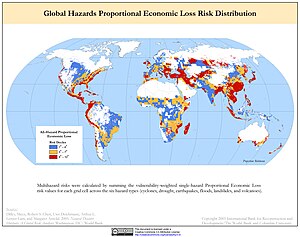
Back Natuurramp Afrikaans Naturkatastrophe ALS Desastre natural AN كارثة طبيعية Arabic প্ৰাকৃতিক দুৰ্যোগ Assamese Desastre natural AST Təbii fəlakət Azerbaijani طبیعی حادیثهلر AZB Тәбиғәт һәләкәте Bashkir Natuakatastrophn BAR

A natural disaster is the highly harmful impact on a society or community following a natural hazard event. Examples of natural hazard events include floods, droughts, earthquakes, tropical cyclones, volcanic activity, wildfires.[1] A natural disaster can cause loss of life or damage property, and typically leaves economic damage in its wake. The severity of the damage depends on the population's disaster preparedness and on the existing infrastructure.[2] Scholars have been saying that the term natural disaster is unsuitable and should be abandoned.[3] Instead, the simpler term disaster could be used, while also specifying the category (or type) of hazard.[4][5][6] A disaster is a result of a natural or human-made hazard impacting a vulnerable community. It is the combination of the hazard along with exposure of a vulnerable society that results in a disaster.
In modern times, the line between natural and human-made disasters is difficult to draw.[3][7][8] In fact, the term natural disaster was called a misnomer already in 1976.[6] Human choices around for example architecture,[9] fire risk,[10][11] and resource management[12] potentially play a role in causing or worsening natural disasters. Climate change also has an impact on the frequency of those disasters that are caused by extreme weather hazards (or "climate hazards"), such as floods, heatwaves, wildfires and tropical cyclones.[13]
Natural disasters can be worsened for example by inadequate building norms, marginalization of people and poor choices on land use planning.[3] Many developing countries lack effective disaster risk reduction systems.[14] This makes them more vulnerable to natural disasters than high income countries. An adverse event will only rise to the level of a disaster if it occurs in an area with a vulnerable population.[15][16]
- ^ "Natural Hazards | National Risk Index". hazards.fema.gov. FEMA. Retrieved 2022-06-08.
- ^ G. Bankoff; G. Frerks; D. Hilhorst, eds. (2003). Mapping Vulnerability: Disasters, Development and People. Routledge. ISBN 1-85383-964-7.[page needed]
- ^ a b c "Why natural disasters aren't all that natural". openDemocracy. 2020-11-26. Archived from the original on 2020-11-29. Retrieved 2020-12-29.
- ^ Cite error: The named reference
:4was invoked but never defined (see the help page). - ^ Cannon, Terry. (1994). Vulnerability Analysis and The Explanation Of 'Natural' Disasters. Disasters, Development and Environment.
- ^ a b Cite error: The named reference
:2was invoked but never defined (see the help page). - ^ Gould, Kevin A.; Garcia, M. Magdalena; Remes, Jacob A.C. (1 December 2016). "Beyond 'natural-disasters-are-not-natural': the work of state and nature after the 2010 earthquake in Chile". Journal of Political Ecology. 23 (1): 93. doi:10.2458/v23i1.20181.
- ^ Smith, Neil (2006-06-11). "There's No Such Thing as a Natural Disaster". Items. Archived from the original on 2021-01-22. Retrieved 2020-12-29.
- ^ Coburn, Andrew W.; Spence, Robin JS; Pomonis, Antonios (1992). "Factors determining human casualty levels in earthquakes: mortality prediction in building collapse" (PDF). Proceedings of the tenth world conference on earthquake engineering. Vol. 10. pp. 5989–5994. ISBN 978-90-5410-060-7. Archived (PDF) from the original on 2020-11-12. Retrieved 2020-12-29.
- ^ "Wildfire Causes and Evaluations (U.S. National Park Service)". NPS.gov Homepage (U.S. National Park Service). 2018-11-27. Archived from the original on 2021-01-01. Retrieved 2020-12-29.
- ^ DeWeerdt, Sarah (2020-09-15). "Humans cause 96% of wildfires that threaten homes in the U.S." Anthropocene. Archived from the original on 2020-12-10. Retrieved 2020-12-29.
- ^ Smil, Vaclav (18 December 1999). "China's great famine: 40 years later". BMJ. 319 (7225): 1619–1621. doi:10.1136/bmj.319.7225.1619. PMC 1127087. PMID 10600969.
- ^ McGuire, Bill (2012). Waking the Giant: How a changing climate triggers earthquakes, tsunamis, and volcanoes. Oxford University Press. ISBN 978-0-19-959226-5. Archived from the original on 2022-04-18. Retrieved 2020-12-29.[page needed]
- ^ Zorn, Matija (2018), Pelc, Stanko; Koderman, Miha (eds.), "Natural Disasters and Less Developed Countries", Nature, Tourism and Ethnicity as Drivers of (De)Marginalization: Insights to Marginality from Perspective of Sustainability and Development, Perspectives on Geographical Marginality, vol. 3, Cham: Springer International Publishing, pp. 59–78, doi:10.1007/978-3-319-59002-8_4, ISBN 978-3-319-59002-8, retrieved 2022-06-08
- ^ D. Alexander (2002). Principles of Emergency planning and Management. Harpended: Terra publishing. ISBN 1-903544-10-6.
- ^ B. Wisner; P. Blaikie; T. Cannon & I. Davis (2004). At Risk – Natural hazards, people's vulnerability and disasters. Wiltshire: Routledge. ISBN 0-415-25216-4.[page needed]
© MMXXIII Rich X Search. We shall prevail. All rights reserved. Rich X Search